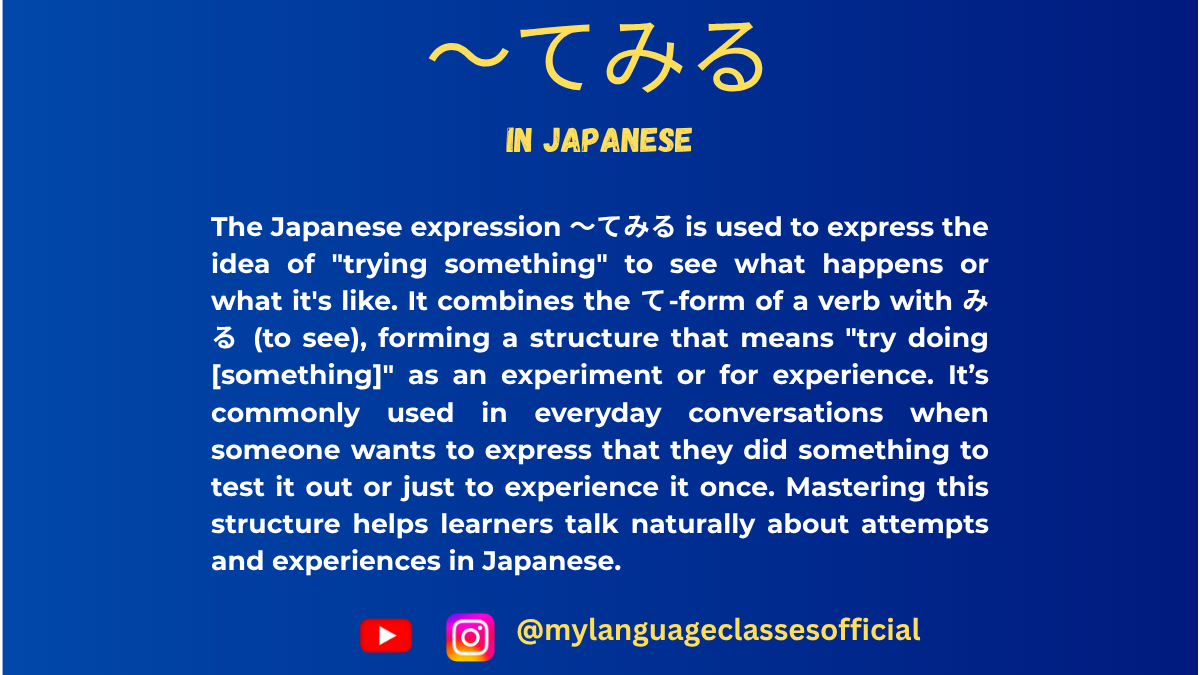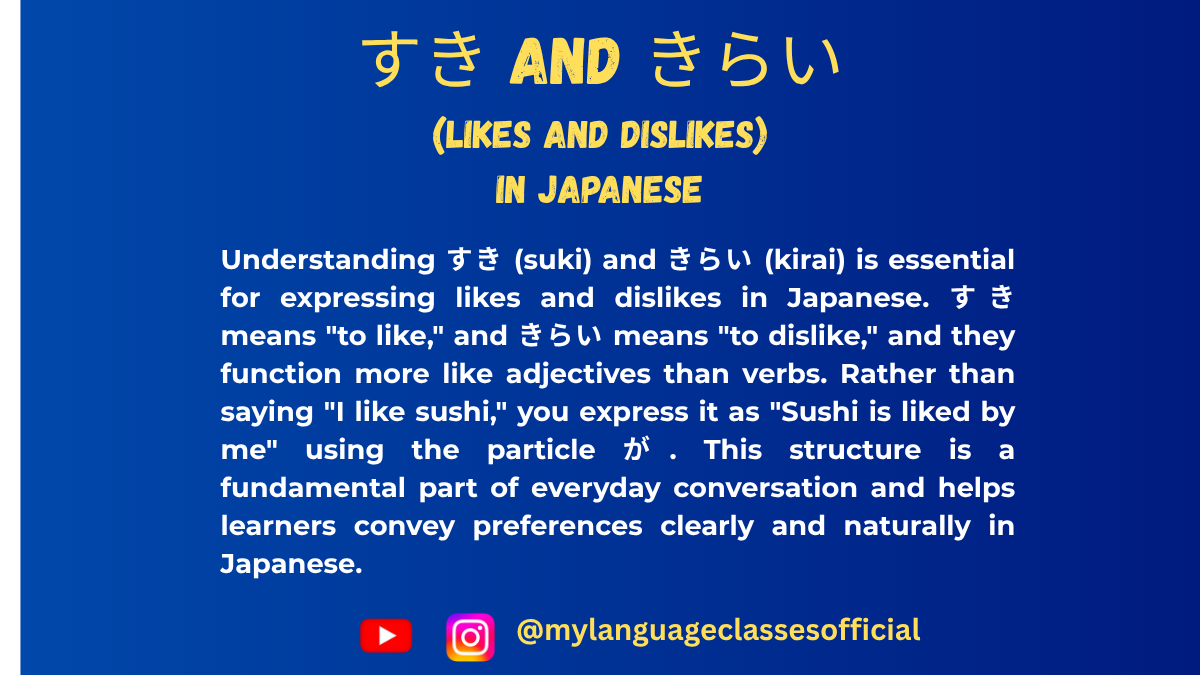Your cart is currently empty!
Tag: Japanese practice
-

Using 〜てみる in Japanese | My Language Classes
Mastering 〜てみる in Japanese
If you’re learning Japanese, you’ve likely come across the phrase 〜てみる (te miru). This little-known but essential grammar point is a game-changer for expressing curiosity, experimentation, or trying something new.
In this extensive guide, we’ll reveal everything you need to know about 〜てみる, including its meaning, usage, and mind-blowing examples that will take your Japanese to the next level. Don’t miss out on this must-know Japanese grammar point—here’s why it’s so important!
What is 〜てみる in Japanese?
〜てみる is a Japanese grammar structure that combines the te-form of a verb with the auxiliary verb みる (miru), which means “to see” or “to try.” Together, 〜てみる translates to “try to do something” or “give something a try.” It’s used when you want to express the idea of experimenting with an action or attempting something for the first time.
For example:
- 食べてみる (tabete miru) – Try to eat / Give eating a try.
- 読んでみる (yonde miru) – Try to read / Give reading a try.
This structure is incredibly versatile and can be used in both casual and formal contexts. Whether you’re trying new food, testing a new skill, or experimenting with a hobby, 〜てみる is your go-to expression.
How to Use 〜てみる: A Step-by-Step Guide
Step 1: Conjugate the Verb into its Te-Form
To use 〜てみる, you first need to conjugate the verb into its te-form. Here’s a quick refresher on how to do that:
- Group 1 (U-verbs): Change the final -u sound to -te or -de (e.g., 書く → 書いて, 飲む → 飲んで).
- Group 2 (Ru-verbs): Replace る with て (e.g., 食べる → 食べて).
- Irregular Verbs: する → して, 来る → 来て (きて).
Step 2: Add みる
Once you have the te-form, simply add みる to the end of the verb. For example:
- 見る (miru) → 見てみる (mite miru) – Try to watch.
- 作る (tsukuru) → 作ってみる (tsukutte miru) – Try to make.
Step 3: Adjust for Politeness
In casual conversations, 〜てみる is perfectly fine. However, in formal situations, you can use 〜てみます (te mimasu) to sound more polite. For example:
- 食べてみます (tabete mimasu) – I will try to eat.
When to Use 〜てみる
1. Trying Something New
〜てみる is often used when you’re trying something for the first time. It conveys a sense of curiosity or experimentation.
- Example: この料理を食べてみたいです。
Romaji: Kono ryouri o tabete mitai desu.
Translation: I want to try this dish.
2. Testing an Idea or Hypothesis
You can also use 〜てみる to test an idea or see how something works.
- Example: この方法を試してみましょう。
Romaji: Kono houhou o tameshite mimashou.
Translation: Let’s try this method.
3. Encouraging Someone to Try Something
〜てみる is great for encouraging others to give something a try.
- Example: このゲームをやってみて!
Romaji: Kono geemu o yatte mite!
Translation: Try playing this game!
Nuances of 〜てみる vs. Other “Try” Expressions
〜てみる vs. 〜ようとする
While 〜てみる means “to try something to see how it is,” 〜ようとする means “to attempt to do something.”
- Example:
- 食べてみる (tabete miru) – Try eating (to see how it tastes).
- 食べようとする (tabeyou to suru) – Attempt to eat (but might not succeed).
〜てみる vs. 〜てみせる
〜てみせる means “to try something to show someone else.”
- Example:
- やってみる (yatte miru) – Try doing something.
- やってみせる (yatte miseru) – Try doing something to show someone.
Negative and Past Tense Forms of 〜てみる
Negative Form: 〜てみない
Use 〜てみない to say “not try” or 〜てみなかった to say “didn’t try.”
- Example:
- 食べてみない (tabete minai) – I won’t try eating.
- 食べてみなかった (tabete minakatta) – I didn’t try eating.
Past Tense: 〜てみた
Use 〜てみた to say “tried.”
- Example:
- 食べてみた (tabete mita) – I tried eating.
Casual vs. Polite Forms
Casual: 〜てみる
- Example: やってみる (yatte miru) – I’ll try doing it.
Polite: 〜てみます
- Example: やってみます (yatte mimasu) – I will try doing it.
Common Mistakes to Avoid
Mistake 1: Confusing 〜てみる with 〜ておく
- Incorrect: 食べておく (tabete oku) – Eat in advance.
- Correct: 食べてみる (tabete miru) – Try eating.
Mistake 2: Using 〜てみる for Future Intentions
- Incorrect: 明日、食べてみる (ashita, tabete miru) – Tomorrow, I’ll try eating.
- Correct: 明日、食べてみたい (ashita, tabete mitai) – Tomorrow, I want to try eating.
Advanced Usage in Compound Sentences
With Conditionals (〜たら)
- Example: 食べてみたら、美味しかった (tabete mitara, oishikatta) – When I tried eating it, it was delicious.
With Conjunctions (〜ので、〜けど)
- Example: やってみたけど、難しかった (yatte mita kedo, muzukashikatta) – I tried doing it, but it was hard.
Cultural Context
In Japanese culture, 〜てみる is often used when trying new foods, activities, or experiences.
- Example: 日本の温泉に入ってみたい (Nihon no onsen ni haitte mitai) – I want to try entering a Japanese hot spring.
Example Sentences: 〜てみる in Action
Here are ten jaw-dropping example sentences that showcase the versatility of 〜てみる. Each sentence includes romaji and English translation to help you master this grammar point.
- この本を読んでみました。
Romaji: Kono hon o yonde mimashita.
Translation: I tried reading this book. - 新しいレストランに行ってみたい。
Romaji: Atarashii resutoran ni itte mitai.
Translation: I want to try going to the new restaurant. - このシャツを着てみてもいいですか?
Romaji: Kono shatsu o kite mite mo ii desu ka?
Translation: Can I try on this shirt? - 日本語で話してみてください。
Romaji: Nihongo de hanashite mite kudasai.
Translation: Please try speaking in Japanese. - この薬を飲んでみたら、元気になりました。
Romaji: Kono kusuri o nonde mitara, genki ni narimashita.
Translation: After trying this medicine, I felt better. - 彼のアドバイスを聞いてみました。
Romaji: Kare no adobaisu o kiite mimashita.
Translation: I tried listening to his advice. - このアプリを使ってみたら、便利でした。
Romaji: Kono apuri o tsukatte mitara, benri deshita.
Translation: When I tried using this app, it was convenient. - この映画を見てみたいと思っています。
Romaji: Kono eiga o mite mitai to omotte imasu.
Translation: I’m thinking of trying to watch this movie. - この方法を試してみたら、成功しました。
Romaji: Kono houhou o tameshite mitara, seikou shimashita.
Translation: When I tried this method, it worked. - このゲームをやってみたら、面白かったです。
Romaji: Kono geemu o yatte mitara, omoshirokatta desu.
Translation: When I tried playing this game, it was fun.
Fill in the Blanks: Test Your Knowledge
Now that you’ve learned about 〜てみる, it’s time to test your skills! Fill in the blanks with the correct form of 〜てみる.
- このケーキを__。 (食べる)
- あの映画を__。 (見る)
- 新しいカフェに__。 (行く)
- このシャツを__。 (着る)
- 日本語で__。 (話す)
- この方法を__。 (試す)
- 彼のアドバイスを__。 (聞く)
- このアプリを__。 (使う)
- この本を__。 (読む)
- このゲームを__。 (やる)
Answers to Fill in the Blanks
- 食べてみる
- 見てみる
- 行ってみる
- 着てみる
- 話してみる
- 試してみる
- 聞いてみる
- 使ってみる
- 読んでみる
- やってみる
Why 〜てみる is a Must-Know Grammar Point
Mastering 〜てみる is essential for anyone looking to achieve fluency in Japanese. It’s a versatile and practical grammar point that allows you to express curiosity, experimentation, and encouragement. By incorporating 〜てみる into your daily conversations, you’ll sound more natural and confident in Japanese.
Final Thoughts
The 〜てみる structure is a proven way to elevate your Japanese skills. Whether you’re trying new foods, testing out hobbies, or encouraging others, this grammar point is a must-know for every Japanese learner. Don’t make the mistake of overlooking it—start using 〜てみる today and watch your Japanese reach legendary levels!
Before it’s too late, practice the examples and fill-in-the-blank exercises in this guide. Guaranteed, you’ll see a breakthrough in your language mastery.
If you enjoyed this lesson, be sure to check out more posts like this on my blog at My Language Classes. Don’t forget to subscribe my YouTube channel and follow me on Instagram for the latest language learning tips and lessons. Leave a comment below to share your thoughts, or ask any questions you have about nouns.
Happy learning! 😊
-

Expressing Likes and Dislikes すき and きらい in Japanese | My Language Classes
Likes and Dislikes in Japanese
こんにちは!(Konnichiwa!)
Learning how to express preferences is one of the most useful and fun parts of mastering Japanese. Today, let’s dive into two essential words: 好き (すき) for “like” and 嫌い (きらい) for “dislike.” Not only will we explore their meanings, but also how to use them naturally in sentences.
1. 好き (すき) – To Like
How to Use 好き
The word 好き means “like” or “fond of” and is commonly used to express your preferences. The structure is simple:
Noun + が好き
This translates to “I like [noun].”Examples:
- 日本語が好きです。
Nihongo ga suki desu.
I like Japanese.- Here, 日本語 (Nihongo) means “Japanese,” and が marks it as the topic you like. Adding です makes it polite.
- 犬が好き。
Inu ga suki.
I like dogs.- This informal version is common among friends or in casual settings.
Expressing Love or Passionate Likes
To emphasize your love or deep passion for something, you can use 大好き (だいすき/daisuki):
- チョコレートが大好きです!
Chokorēto ga daisuki desu!
I love chocolate!
2. 嫌い (きらい) – To Dislike
How to Use 嫌い
On the flip side, 嫌い means “dislike” or “hate.” The structure is the same as 好き:
Noun + が嫌い
This means “I dislike [noun].”Examples:
- ピザが嫌いです。
Piza ga kirai desu.
I dislike pizza.- ピザ (Piza) means “pizza.” While it’s a popular dish, some people might find it too greasy!
- 虫が嫌い。
Mushi ga kirai.
I hate insects.- 虫 (Mushi) refers to “insects.” Use this informal structure with friends.
Expressing Strong Dislike
If you strongly dislike something, you can say 大嫌い (だいきらい/daikirai):
- 雨が大嫌いです!
Ame ga daikirai desu!
I hate rain!
3. Cultural Notes
- “Softer Tone for Dislikes”: In Japanese culture, direct expressions of dislike like 嫌い might come off as too strong in some situations. To soften it, you can use phrases like:
- あまり好きじゃない (Amari suki janai) – “I don’t really like [it].”
- ちょっと苦手です (Chotto nigate desu) – “I’m a bit bad with [it].”
- Overuse of 好き: While 好き is positive, saying it too often might sound insincere. Balance your expressions to match the context.
4. Grammar and Nuance Tips
- No Verb Needed:
Both 好き and 嫌い function as な-adjectives, not verbs. This means they don’t need any conjugation or additional verbs to form basic sentences.Example:- Correct: 猫が好きです。 (Neko ga suki desu. – “I like cats.”)
- Incorrect: 猫が好きをです。 (Neko ga suki wo desu. – This is ungrammatical.)
- が (Ga) vs. は (Wa):
Although が is standard for these structures, は can be used for contrast or emphasis:- 犬は好きですが、猫は嫌いです。
Inu wa suki desu ga, neko wa kirai desu.
I like dogs, but I dislike cats.
- 犬は好きですが、猫は嫌いです。
5. Practice Time!
Let’s put what you’ve learned into action. Try completing these sentences:
- 私は ______ が好きです。
(Watashi wa ______ ga suki desu.)- Translate: “I like ______.”
- 友達は ______ が嫌いです。
(Tomodachi wa ______ ga kirai desu.)- Translate: “My friend dislikes ______.”
- ______ は大好きです!
(______ wa daisuki desu!)- Translate: “I love ______!”
6. Wrap-Up
Now you can confidently express what you like and dislike in Japanese! Start practicing by talking about your favorite foods, hobbies, and activities. Try to notice how native speakers use 好き and 嫌い in conversations—it will deepen your understanding.
If you have questions or want to share your sentences, feel free to leave a comment below!
それでは、またね!(Soredewa, matane!)If you enjoyed this lesson, be sure to check out more posts like this on my blog at My Language Classes. Don’t forget to subscribe my YouTube channel and follow me on Instagram for the latest language learning tips and lessons. Leave a comment below to share your thoughts, or ask any questions you have about nouns.
Happy learning! 😊
- 日本語が好きです。
